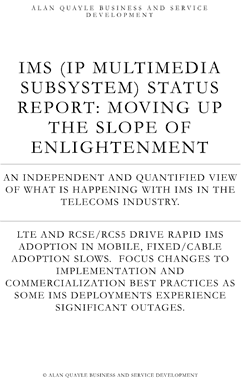An independent and quantified view of what is happening with IMS in the telecoms industry. LTE and RCSe/RCS5 drive rapid adoption in mobile, fixed/cable adoption slows. Focus changing to implementation and commercialization best practices as some IMS deployments experience significant outages.
 Published: March 2012
Published: March 2012
Pages: 164
Figures: 132
Operators Interviewed: 82 (plus an additional 40 suppliers)
Detailed Operator Case Studies: 6 names, 2 unnamed, and 1 general discussion on implementation challenges
Single User: $499
Company License: Contact me
You are buying an electronic document. Upon payment, an email
will be sent with a link and password to download this report.
View more details: Table of Contents and Foreword
Summary:
This report provides an extensive update to the original IMS Status Report written in 2009, it compares and contrasts the 2009 and 2012 results to understand how the industry has changed. It also provides an update on the status of IMS (IP Multimedia Subsystem) based on a market survey performed from November 2011 to January 2012, and a review of the over-the-top services impacting operators who are responding with developments such as RCSe/RCS5 (Rich Communications Suite enhanced) which should not be confused with RCS (Rich Communications Suite) . The two have very different user experiences and business purposes, as will be discussed in this report.
The report is 164 pages long, with 82 diagrams, and brings together the thoughts of 122 respondents (82 operators) to the 2012 survey, and 137 respondents from the 2009 survey. With 6 named operator case studies, 2 un-named, and 1 general discussion on what operators are discovering in the practical implementation of IMS that bring together many of the informal discussions stimulated during the questionnaire. With a set of frank independent recommendations on what IMS means to all members of the ecosystem.
So where is IMS? Verizon continues its aggressive roll-out, accelerated by its commitment to LTE (Long Term Evolution) and VoLTE (Voice over LTE). Though as we’ve seen over the past year it has suffered a significant number of IMS outages. We’ll discuss generically the issues with IMS that are leading to the problems operators are experiencing in deploying IMS. Many mobile operators that were circumspect on IMS in the 2009 report have now implemented IMS as part of their LTE roll-out or RCSe/RCS5 plans, for example Rogers Wireless in Canada. Put simply, they changed their minds. Advanced voice services are now being launched on IMS, e.g. enterprise unified communications.
The business focus of the industry has moved to remaining relevant to customers as the communication service provider as over the top voice services continue their rise in customers’ awareness. SIP (Session Initiation Protocol) application servers are being purchased to enable a range of new communication services and capabilities built on IMS, many of those services are being enabled through APIs (Application Program Interfaces). Third parties and existing partners of the operator are being brought into the mix to enable innovation and go to market strategies that operators alone would struggle to achieve.
No one can argue against the need for IP multimedia session control with dynamic QoS (Quality of Service), to enable ‘reliable as the PSTN’ voice communications across any capable network, and for call features to work transparently across those disparate networks and around the world. Given the recent transition to all IP in mobile operators over the past year with their investment in LTE, IMS is moving up the slope of enlightenment.
The focus has moved on from whether to not to move from an IMS trial to deployment, rather the focus is now to set out and implement a robust IMS-enabled service roadmap focused on keeping the operator relevant to customers as their primary communication service provider. As we will see from the survey and case studies, the implementation of IMS is not set in stone as we adapt technology defined one decade ago in standards meetings to the market and technology realities of today.
This document continues to aim at providing a valuable independent status report that can help all in the industry have a clear view on the current status of IMS, the likely paths operators will take in the evolution of their networks, and a status report on the impact of over the top voice and the industry’s competitive and cooperative reaction.
